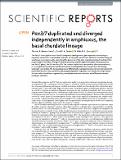Files in this item
Pax3/7 duplicated and diverged independently in amphioxus, the basal chordate lineage
Item metadata
| dc.contributor.author | Barton-Owen, Thomas | |
| dc.contributor.author | Ferrier, David E. K. | |
| dc.contributor.author | Somorjai, Ildikó M. L. | |
| dc.date.accessioned | 2018-06-20T11:30:06Z | |
| dc.date.available | 2018-06-20T11:30:06Z | |
| dc.date.issued | 2018-06-20 | |
| dc.identifier | 250513684 | |
| dc.identifier | ec8497e0-39a6-4afc-b309-2ee5b651ca82 | |
| dc.identifier | 85048892092 | |
| dc.identifier | 000435630400019 | |
| dc.identifier.citation | Barton-Owen , T , Ferrier , D E K & Somorjai , I M L 2018 , ' Pax3/7 duplicated and diverged independently in amphioxus, the basal chordate lineage ' , Scientific Reports , vol. 8 , 9414 . https://doi.org/10.1038/s41598-018-27700-x | en |
| dc.identifier.issn | 2045-2322 | |
| dc.identifier.other | ORCID: /0000-0003-3247-6233/work/45947559 | |
| dc.identifier.other | ORCID: /0000-0001-5243-6664/work/46168676 | |
| dc.identifier.uri | https://hdl.handle.net/10023/14330 | |
| dc.description | Funding for this research was provided by the European Union’s Horizon 2020 research and innovation programme under grant agreement number 654428 (“CORBEL”) and a MASTS (Marine Alliance for Science and Technology Scotland) PECRE young investigator award to IMLS. This work was supported by the Branchiostoma lanceolatum genome consortium, which provided access to the Branchiostoma lanceolatum genome sequence. | en |
| dc.description.abstract | The Pax3/7 transcription factor family is integral to developmental gene networks contributing to important innovations in vertebrate evolution, including the neural crest. The basal chordate lineage of amphioxus is ideally placed to understand the dynamics of the gene regulatory network evolution that produced these novelties. We report here the discovery that the cephalochordate lineage possesses two Pax3/7 genes, Pax3/7a and Pax3/7b. The tandem duplication is ancestral to all extant amphioxus, occurring in both Asymmetron and Branchiostoma, but originated after the split from the lineage leading to vertebrates. The two paralogues are differentially expressed during embryonic development, particularly in neural and somitic tissues, suggesting distinct regulation. Our results have implications for the study of amphioxus regeneration, neural plate and crest evolution, and differential tandem paralogue evolution. | |
| dc.format.extent | 11 | |
| dc.format.extent | 2623671 | |
| dc.language.iso | eng | |
| dc.relation.ispartof | Scientific Reports | en |
| dc.subject | QH301 Biology | en |
| dc.subject | NDAS | en |
| dc.subject | BDC | en |
| dc.subject.lcc | QH301 | en |
| dc.title | Pax3/7 duplicated and diverged independently in amphioxus, the basal chordate lineage | en |
| dc.type | Journal article | en |
| dc.contributor.sponsor | European Commission | en |
| dc.contributor.institution | University of St Andrews. School of Biology | en |
| dc.contributor.institution | University of St Andrews. Marine Alliance for Science & Technology Scotland | en |
| dc.contributor.institution | University of St Andrews. Scottish Oceans Institute | en |
| dc.contributor.institution | University of St Andrews. Biomedical Sciences Research Complex | en |
| dc.identifier.doi | https://doi.org/10.1038/s41598-018-27700-x | |
| dc.description.status | Peer reviewed | en |
| dc.identifier.grantnumber | 654248 | en |
This item appears in the following Collection(s)
Items in the St Andrews Research Repository are protected by copyright, with all rights reserved, unless otherwise indicated.

